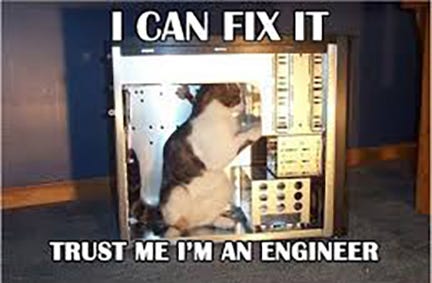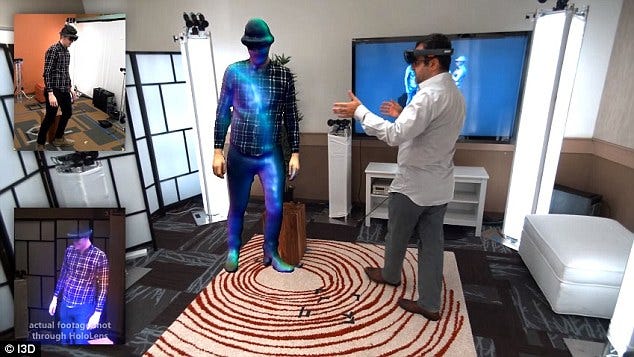4 Examples of How AR & VR Will Improve Customer Service
4 Examples of How AR & VR Will Improve Customer Service
- Last Updated: December 2, 2024
Scottie Gardonio
- Last Updated: December 2, 2024



Great customer service is still alive and well in many businesses, but others are seeing more red-flag comments and lowered scores. With the internet at our fingertips at every moment, there’s no hiding a bad experience, so any and all are quickly there for us to post for all to see.

Image Credit: I Waste So Much Time
In a world where fears abound surrounding whether virtual reality will have us hunkered up in dark rooms attached to machines straight out of Bruce Willis’s Surrogates — unlikely to see another physical being for weeks at a time — could that same technology actually help or save declining customer service?
Why yes, I think it can.
Where We Currently See Breakdowns in Customer Service
We can all see where voids can happen, causing actual or perceived bad customer service. In fact, you may have already thought of one that happened recently. The lists are endless, but there’s a handful of common complaints plastered on review sites for both online and in-person consumer goods.
Customer service is always a human-to-human interaction in which we want and demand a personal touch, empathy, and help. Where we currently lack the technical abilities to provide such experiences, often across distance, further technological advances in AR and VR can and should be used to provide solutions allowing for better consumer experiences.
Flash forward to a super random date in time, say 2042. (I, personally, hope some of this technology doesn’t take that long, but 42 is always a good answer. For those of you who don’t know why, might I suggest some “light” reading surrounding the topics of interstellar highways, dolphins, and sad robots?)
Anyway, we’re in 2042. We’re still walking around as humans, interacting with each other in a physical world, and we’re consuming products in much the same way we do today.
1. The Dreaded Call Center
Hours of mind-melting hold music, fourteen different numbers to push in the hope of finding the appropriate department, and a bad connection that makes clear communication difficult all plague this consumer torment.
Imagine for a moment, though, that you are instead enlisting an AR device during what is normally a frustrating conversation.
Do you remember when you ordered that amazingly chic, Pinterest-esque cascading lawn fountain? You couldn’t have been more excited for it to arrive, but when it did, you discovered the company accidentally shipped a twelve-foot tall, fully-lit pink flamingo (who even orders something like that?).
On your call to customer service, a normal conversation can range from anything to, “we show we shipped you the fountain, so I can’t do anything since that’s what I show you have,” to “since it’s an item over ‘X’ value, we would need you to ship it back to us at your expense,” or “we’ve never had anyone order something like that.”

Image courtesy HoloLens
Instead, wouldn’t it be easier for both parties to use an AR enabled device, allowing the customer service representative to appear in your space. Now, as you can both see each other, the interaction is much more human. You see him, making him a human you’re less likely to scream at, and he sees you, making you more than just another voice in a long line of complaints.
From there, you walk out to your lawn where your neighbors have gathered to sign a petition in order for the flamingo to be removed, and the representative can see the error.
Now, not only do you have a more human interaction, encouraging compassion on both sides, you’re able to base the remainder of the conversation on information you both share. Whereas the agent previously only had paperwork in which to gauge a proper response, he now has proof and is more likely to come to a swift solution.
2. The Contractor
You’ve done your research and asked for Facebook recommendations, but you still feel apprehensive about hiring someone you’ve never met to do work on your house.
Handymen and contractors are often seen under the guise of swindlers — taking longer than they should and causing themselves extra work to gain extra pay. While many deserve the good reputations they carve for themselves, trust is earned at a personal level.
In this instance, you’ve requested a kitchen remodel, which will require the group to work in your home while you’re away at the office. On just the first day, you’ve gotten three calls. One stated they didn’t bring the right equipment, so they’d be back at a different time. Another call indicated the work was more intensive than they’d expected — they need to remove a weight-bearing beam — so charges will increase. The third indicates they’ll be changing the layout from what was discussed due to the beam removal.
The team lead tries to describe how it will look, but you’re having a hard time envisioning it. They’d shown drawings to start, but now that those are void, you feel the need to see a new visual in order to agree to the work.
When you finally arrive home, you see your kitchen is in utter disarray, but you can’t make sense out of what kind of progress they did or didn’t make during the day.
When we bring future AR/VR capabilities into the mix, we are able to re-add confidence and trust.
Now, if you wonder what the team of contractors does while you’re away, you simply trigger your AR or VR device. By way of AR, you can view a miniature, 3-D, realtime stream of your kitchen. VR would allow for the same, but in a different way (i.e. via a headset or by viewing a 360 video remotely).
You may be asking why we don’t just use cameras for this now, but remember that just because we have that capability doesn’t make it as useful. One nanny cam in your home doesn’t show the whole picture, and such cameras are easily moved.

Image courtesy IKEA VR Showroom
At this point, when you get the call from the lead about the beam removal and the subsequent design changes, you’re also provided with visuals. 3-D models show why the beam must be removed and indicate the extra work involved to shore up the rest of the home.
By way of VR, you can be transported into the newly-designed kitchen, and you are able to make educated decisions as to how you want to proceed.
Naturally, there is a certain amount of time necessary to create these modeled visuals, but when you cannot personally supervise work, the extra time spent getting everyone on the same page is worth the effort for both parties.

3. The Crowded Restaurant
We’ve all been there — the crowded restaurant where the person who fills your water is different from the one who takes your order, and another, still, brings your food. You flag down a server at the next table to indicate you’d like another beverage or to state your food is cold and incorrect, but you’re informed it’s not his/her table.
Often, especially in popular, crowded restaurants, efficiency is a key driver in how operations are run. However, when you are unable to make a personal connection with the person providing service, or indeed are unable to determine which of the many faces are at your disposal, a perceived lack of acceptable customer service can form.
While we cannot fix every challenge within the restaurant industry, augmented reality can be a useful tool in creating an environment in which we feel as though our concerns and care are of top priority.
Imagine for a moment that you’re in Bernadette’s Lettuce Bistro (it’s all the rage in the 2042, and yes, they only serve lettuce). While you may still have the different types of servers attending to your table (water-filler, order-taker, food-bringer), you have another unseen attendant in the back.
In a dedicated corner, out of sight from the public, there is an AR display showing the entire restaurant. It shows the tables, patrons, staff movements, etc.
In between the time the “food-bringer” delivers the food to your table and the when the “order-taker” comes back to check on things, this unsung hero in the back noticed a few things regarding your table.
- Your beverage glass is nearly empty.
- You took a bite of lettuce, made a face, and then looked around for something.
- You’ve put your utensils down and are no longer eating.
In a normal restaurant scenario, you may wait five or more minutes before getting ahold of a server willing to claim your table as his/hers. Five minutes may not seem like a lot of time in the grand scheme of things, but in customer service, that is five minutes for someone to seethe at an increasing rate. Five minutes is enough to make a final decision on the quality of an establishment. It’s plenty of time to build up enough anger to then project onto the awaiting staff, and it’s more than enough time to pull out a mobile device for an online review or scathing social media post.
Instead, Bernadette’s dedicated AR staffer sees these actions as key indicators that your table needs immediate attention. Now, as a server approaches your table, prior to even speaking with you, your concerns are addressed. You’re asked if you’d like another beverage and what can be done to make the lettuce more to your liking.

Image courtesy Design Taxi
4. In-Person Shopping
You walk into your local computer store, let’s call it Larry’s Computational Emporium. There, you look at computers for roughly thirty minutes, trying to figure out why one is $1,000 more than another. You’re not a computer engineer, after all. You’d have bought something online if you could, but you’d hoped to speak to a clerk for assistance in making the right decision for your needs.
After thirty minutes, you hike around the Emporium’s aisles, desperately trying to find help. You finally locate eight employees having a Blow-Pop meeting near the tech-enhanced refrigerators (they monitor your weight and eating habits — chastising comments are optional). When you ask for help, you get a round of blank stares followed by a couple eye rolls and the very distinct impression that you are thoroughly bothering these people by asking them to “do their job.”
After fifteen minutes of hearing technical terms and acronyms referring to things outside the realm of your expertise, feeling as though you’re being talked down to by a person ten to fifteen years your junior, you make a slightly-educated decision on a computer.
Instead, let’s head back to Larry’s Computational Emporium with AR/VR. We walk in, and we patrol the computer displays for a few minutes. A moment or two later, we’re approached by a young human asking if assistance is needed. There was still, in fact, a Blow-Pop meeting near the refrigerators, but a wrist device buzzed on one human’s wrist indicating someone was in the computer aisles. (No, that’s not AR or VR, but all sorts of other tech is advancing, as well.)
This human still speaks in technical terms and acronyms, but thankfully you’ve downloaded the Larry’s Computational Emporium AR App, and that translates the jargon in a way that makes sense to you. You’ve already selected your expertise level, so when the associate says RAM, your AR device plops an overlay on the scene with, “it’ll make the computer do things faster.”
It’s easy for someone to say we should just train associates to speak in ways more accepted by the public. The inherent problem, however, is that every member of the public has a different level and understanding when it comes to any subject. One individual may walk in knowing about RAM but needs to know more about graphics cards while the next is buying his/her very first computer. Expecting an hourly associate to immediately and accurately assess a shopper’s existing subject knowledge is impractical and unproductive.
We can use our understanding of these shortcomings to improve customer service in other ways. When we empower the consumer with ways to customize the experience, we are creating situations where the experience is fulfilling, helpful, and efficient for all parties involved.
We See Customer Service in Our Every Day Lives.
This will not change as time saunters onward. As advancements in the augmented and virtual reality spaces further enable better experiences across a multitude of platforms, we will better serve our future selves if we remember this technology can also enhance human-to-human interactions.
The Most Comprehensive IoT Newsletter for Enterprises
Showcasing the highest-quality content, resources, news, and insights from the world of the Internet of Things. Subscribe to remain informed and up-to-date.
New Podcast Episode

How Drones and Telecom Enable Aerial IoT
Related Articles





